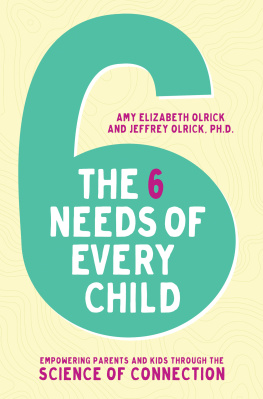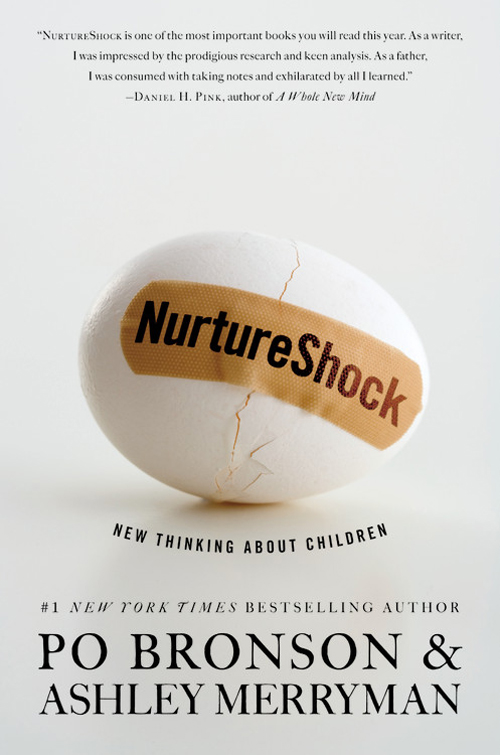
PO BRONSON
&
ASHLEY MERRYMAN

NEW YORK BOSTON
Copyright 2009 by Po Bronson
All rights reserved. Except as permitted under the U.S. Copyright Act of 1976, no part of this publication may be reproduced, distributed, or transmitted in any form or by any means, or stored in a database or retrieval system, without the prior written permission of the publisher.
Twelve
Hachette Book Group
237 Park Avenue
New York, NY 10017
Visit our website at www.HachetteBookGroup.com
www.twitter.com/grandcentralpub
Twelve is an imprint of Grand Central Publishing.
The Twelve name and logo are trademarks of Hachette Book Group, Inc.
The publisher is not responsible for websites (or their content) that are not owned by the publisher.
Chapters 1, 2, and 4 originally appeared in New York magazine in abridged form.
Grateful acknowledgment is made to New York magazine for permission to include these chapters in edited and expanded form.
Second eBook Edition: January 2011
ISBN: 978-0-446-56332-1
Why Do I Love These People?
What Should I Do With My Life?
The Nudist on the Late Shift
The First $20 Million Is Always the Hardest
Bombardiers
Cary Grant is at the door.
D uring the late 1960s, visitors to the Magic Castlea private nightclub in Hollywood, California, run by professional magicianswere often delighted to see that the club had hired a Cary Grant look-alike as its doorman. As theyd step up to the portico, the door would be swung open by a dashing man in an impeccably tailored suit. Welcome to the Castle, he charmed, seeming to enjoy his doppelgnger status. Once the guests were through the lobby, they would titter over just how much the doorman resembled the iconic actor. The nightclub is mere yards from the Chinese Theatre and the Walk of Fame. To have the best Cary Grant impersonator in the world holding the door for you was the perfect embodiment of the magic of Hollywood in all its forms.
However, the doorman pretending to be Cary Grant wasnt an impostor after all. It was, in fact, the real Cary Grant.
Grant, a charter member of the Castle, had been intrigued by magic since he was a kid. Part of the Castles appeal to Grant and many other celebrities, though, was that the club has an ironclad ruleno cameras, no photographs, and no reporters. It gave stars the ability to have a quiet night out without gossip columns knowing.
Grant hung out in the lobby to be with the receptionist, Joan Lawton. They spent the hours talking about a more profound kind of Magicsomething Grant cared more deeply about than the stage.
Children.
Lawtons work at the Castle was her night job. By day, she was pursuing a certificate in the science of child development. Grant, then the father of a toddler, was fascinated by her study. He plied her for every scrap of research she was learning. He wanted to know everything about kids, she recalled. Whenever he heard a car arrive outside, hed jump to the door. He wasnt intentionally trying to fool the guests, but that was often the result. The normally autograph-seeking patrons left him alone.
So why didnt guests recognize he was the real thing?
The context threw them off. Nobody expected the real Cary Grant would appear in the humdrum position of a doorman. Magicians who performed at the Magic Castle were the best anywhere, so the guests came prepared to witness illusions. They assumed the handsome doorman was just the first illusion of the evening.
Heres the thing. When everything is all dressed up as entertainmentwhen its all supposed to be magical and surprising and fascinatingthe Real Thing may be perceived as just another tidbit for our amusement.
That is certainly the case in the realm of science.
In the immediacy of todays 24-7 news cycle, with television news, constant blogging, press releases, and e-mail, it feels as if no scientific breakthrough escapes notice. But these scientific findings are used like B-list celebritiestheyre filler for when the real newsmakers arent generating headlines. Each one gets its ten minutes of fame, more for our entertainment than our serious consideration. The next day, they are tossed aside, lipstick asmear, as the press wire churns out the science du jour. When theyre presented as quick sound bites, its impossible to know which findings really merit our attention.
Most scientific investigations cant live up to the demands of media packaging. At least for the science of child development, there have been no Eureka! moments that fit the classic characterization of a major scientific breakthrough. Rather than being the work of a single scholar, the new ideas have been hashed out by many scholars, sometimes dozens, who have been conducting research at universities the world over. Rather than new truths arriving on the wings of a single experiment, they have come at a crawl, over a decade, from various studies replicating and refining prior ones.
The result is that many important ideas have been right under our noses, building up over the last decade. As a society, collectively, we never recognized they were the real thing.
Why our instincts about children can be so off the mark.
M y wife has great taste in art, with one exception. In the guest bedroom of our house hangs an acrylic still lifea pot of red geraniums beside an ocher-toned watering can, with a brown picket fence in the background. Its ugly, but thats not its worst sin. My real problem is that its from a paint-by-numbers kit.
Every time I look at it, I want to sneak it out of the house and dump it in the corner trash can.
My wife wont let me, though, because it was painted way back in 1961 by her great-grandmother. I am all for hanging on to things for sentimental reasons, and our house is full of her familys artifacts, but I just dont think this painting contains or conveys any genuine sentiment. There was probably a hint of it the day her great-grandmother bought the paint-by-numbers kit at the crafts storea glimmer of a more creative, inspired lifebut the finished product, in my opinion, kind of insults that hope. Rather than commemorating her memory, it diminishes it.
Painting by numbers skyrocketed to success in the early 1950s. It was hugely popularthe iPod of its time. It was marketed on the premise that homemakers were going to have a vast surplus of free time thanks to dishwashers, vacuum cleaners, and washing machines. In three years, the Palmer Paint Company sold over twelve million kits. As popular as the phenomenon was, it was also always surrounded by controversy. Critics were torn between the democratic ideal of letting everyone express themselves and the robotic, conformist way that expression was actually being manifested.
The other day, I was trying to remember how I felt about the science of child development before Ashley Merryman and I began this book, several years agowhen all of a sudden that painting of potted geraniums popped into my head. I had to go home and stare at that ugly painting for an evening before I could figure out why. Which I ultimately realized was this:
The mix of feelings engendered by paint-by-numbers is similar to the mix of feelings engendered by books about the science of children. This is because the science has always carried with it the connotation that parenting should be by the book. If the science says X, youre supposed to do X, just like paint-by-numbers instructed hobbyists to use Cornsilk and Burnt Umber for the handle of the watering can.














